Leadership Styles and Diversity: Reflection and Analysis Report
VerifiedAdded on 2022/09/15
|8
|1844
|24
Report
AI Summary
This report delves into the critical concepts of cultural diversity and inclusion, offering a reflection on personal awareness and biases, as assessed through a cultural diversity questionnaire. The core of the report analyzes the "Blue-eyed, Brown-eyed" experiment conducted by Jane Elliott, examining how the teacher established the classroom climate, how student behaviors varied during the experiment, how the climate was re-established, and the experiment's short-term and long-term impacts on the students. The analysis highlights the development of prejudice, discrimination, and oppression, as well as the effects of reverse psychology and the re-establishment of a unified classroom environment. The report emphasizes the importance of embracing diversity and inclusivity for a thriving society, and how the experiment impacted the students' understanding of stereotypes and biases.
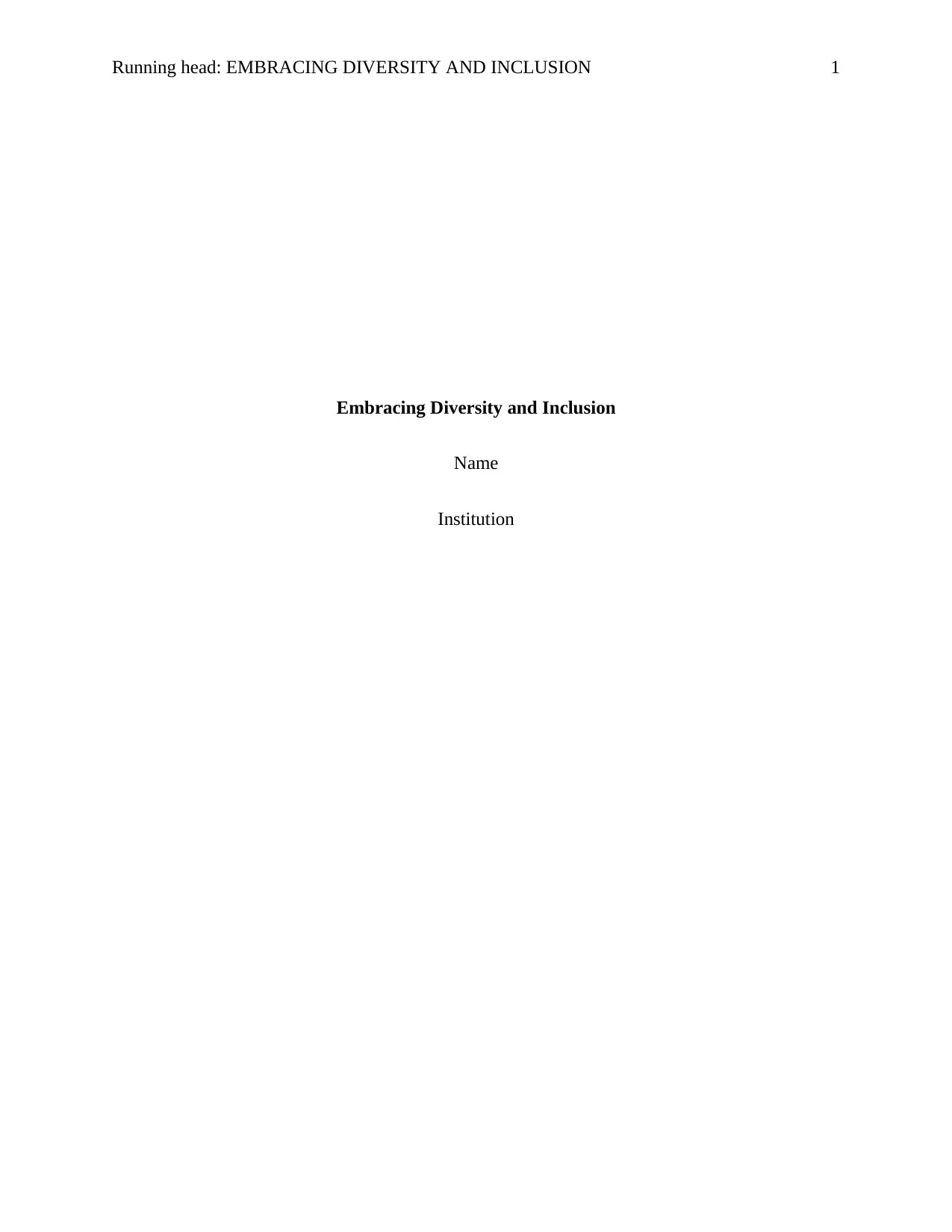
Running head: EMBRACING DIVERSITY AND INCLUSION 1
Embracing Diversity and Inclusion
Name
Institution
Embracing Diversity and Inclusion
Name
Institution
Paraphrase This Document
Need a fresh take? Get an instant paraphrase of this document with our AI Paraphraser
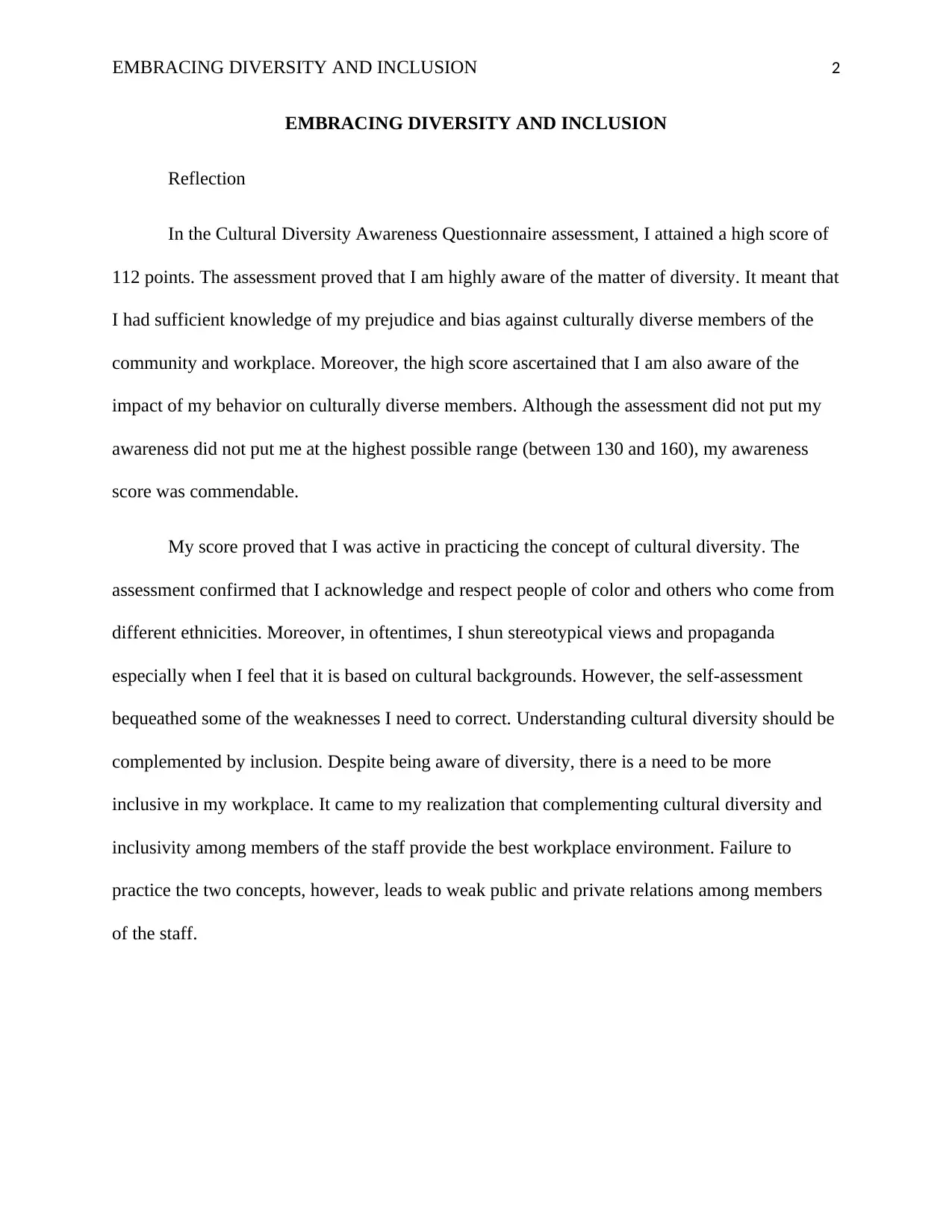
EMBRACING DIVERSITY AND INCLUSION 2
EMBRACING DIVERSITY AND INCLUSION
Reflection
In the Cultural Diversity Awareness Questionnaire assessment, I attained a high score of
112 points. The assessment proved that I am highly aware of the matter of diversity. It meant that
I had sufficient knowledge of my prejudice and bias against culturally diverse members of the
community and workplace. Moreover, the high score ascertained that I am also aware of the
impact of my behavior on culturally diverse members. Although the assessment did not put my
awareness did not put me at the highest possible range (between 130 and 160), my awareness
score was commendable.
My score proved that I was active in practicing the concept of cultural diversity. The
assessment confirmed that I acknowledge and respect people of color and others who come from
different ethnicities. Moreover, in oftentimes, I shun stereotypical views and propaganda
especially when I feel that it is based on cultural backgrounds. However, the self-assessment
bequeathed some of the weaknesses I need to correct. Understanding cultural diversity should be
complemented by inclusion. Despite being aware of diversity, there is a need to be more
inclusive in my workplace. It came to my realization that complementing cultural diversity and
inclusivity among members of the staff provide the best workplace environment. Failure to
practice the two concepts, however, leads to weak public and private relations among members
of the staff.
EMBRACING DIVERSITY AND INCLUSION
Reflection
In the Cultural Diversity Awareness Questionnaire assessment, I attained a high score of
112 points. The assessment proved that I am highly aware of the matter of diversity. It meant that
I had sufficient knowledge of my prejudice and bias against culturally diverse members of the
community and workplace. Moreover, the high score ascertained that I am also aware of the
impact of my behavior on culturally diverse members. Although the assessment did not put my
awareness did not put me at the highest possible range (between 130 and 160), my awareness
score was commendable.
My score proved that I was active in practicing the concept of cultural diversity. The
assessment confirmed that I acknowledge and respect people of color and others who come from
different ethnicities. Moreover, in oftentimes, I shun stereotypical views and propaganda
especially when I feel that it is based on cultural backgrounds. However, the self-assessment
bequeathed some of the weaknesses I need to correct. Understanding cultural diversity should be
complemented by inclusion. Despite being aware of diversity, there is a need to be more
inclusive in my workplace. It came to my realization that complementing cultural diversity and
inclusivity among members of the staff provide the best workplace environment. Failure to
practice the two concepts, however, leads to weak public and private relations among members
of the staff.
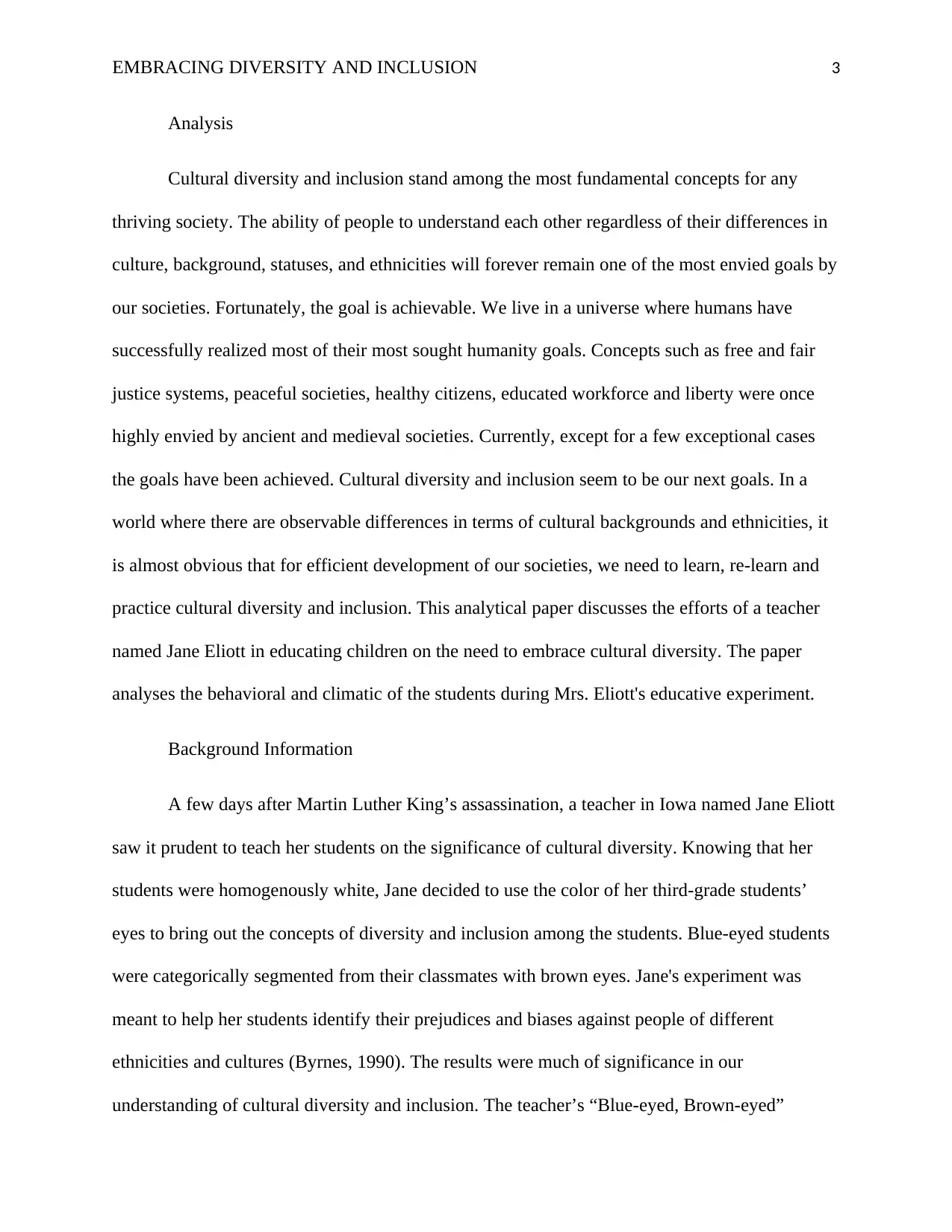
EMBRACING DIVERSITY AND INCLUSION 3
Analysis
Cultural diversity and inclusion stand among the most fundamental concepts for any
thriving society. The ability of people to understand each other regardless of their differences in
culture, background, statuses, and ethnicities will forever remain one of the most envied goals by
our societies. Fortunately, the goal is achievable. We live in a universe where humans have
successfully realized most of their most sought humanity goals. Concepts such as free and fair
justice systems, peaceful societies, healthy citizens, educated workforce and liberty were once
highly envied by ancient and medieval societies. Currently, except for a few exceptional cases
the goals have been achieved. Cultural diversity and inclusion seem to be our next goals. In a
world where there are observable differences in terms of cultural backgrounds and ethnicities, it
is almost obvious that for efficient development of our societies, we need to learn, re-learn and
practice cultural diversity and inclusion. This analytical paper discusses the efforts of a teacher
named Jane Eliott in educating children on the need to embrace cultural diversity. The paper
analyses the behavioral and climatic of the students during Mrs. Eliott's educative experiment.
Background Information
A few days after Martin Luther King’s assassination, a teacher in Iowa named Jane Eliott
saw it prudent to teach her students on the significance of cultural diversity. Knowing that her
students were homogenously white, Jane decided to use the color of her third-grade students’
eyes to bring out the concepts of diversity and inclusion among the students. Blue-eyed students
were categorically segmented from their classmates with brown eyes. Jane's experiment was
meant to help her students identify their prejudices and biases against people of different
ethnicities and cultures (Byrnes, 1990). The results were much of significance in our
understanding of cultural diversity and inclusion. The teacher’s “Blue-eyed, Brown-eyed”
Analysis
Cultural diversity and inclusion stand among the most fundamental concepts for any
thriving society. The ability of people to understand each other regardless of their differences in
culture, background, statuses, and ethnicities will forever remain one of the most envied goals by
our societies. Fortunately, the goal is achievable. We live in a universe where humans have
successfully realized most of their most sought humanity goals. Concepts such as free and fair
justice systems, peaceful societies, healthy citizens, educated workforce and liberty were once
highly envied by ancient and medieval societies. Currently, except for a few exceptional cases
the goals have been achieved. Cultural diversity and inclusion seem to be our next goals. In a
world where there are observable differences in terms of cultural backgrounds and ethnicities, it
is almost obvious that for efficient development of our societies, we need to learn, re-learn and
practice cultural diversity and inclusion. This analytical paper discusses the efforts of a teacher
named Jane Eliott in educating children on the need to embrace cultural diversity. The paper
analyses the behavioral and climatic of the students during Mrs. Eliott's educative experiment.
Background Information
A few days after Martin Luther King’s assassination, a teacher in Iowa named Jane Eliott
saw it prudent to teach her students on the significance of cultural diversity. Knowing that her
students were homogenously white, Jane decided to use the color of her third-grade students’
eyes to bring out the concepts of diversity and inclusion among the students. Blue-eyed students
were categorically segmented from their classmates with brown eyes. Jane's experiment was
meant to help her students identify their prejudices and biases against people of different
ethnicities and cultures (Byrnes, 1990). The results were much of significance in our
understanding of cultural diversity and inclusion. The teacher’s “Blue-eyed, Brown-eyed”
⊘ This is a preview!⊘
Do you want full access?
Subscribe today to unlock all pages.

Trusted by 1+ million students worldwide

EMBRACING DIVERSITY AND INCLUSION 4
experiment was meant to combat the evils of racism and stereotypical beliefs against diverse
cultures (Infinito, 2003). Due to the experiment's popularity and significance, the teacher was
requested to repeat the experiment in 1985. The latter version was filmed and is available online
(Peters, 2019). The video is also available on YouTube under the same title.
The Climate at the Start of the Experiment
Initially, the teacher told her third-graders that blue-eyed students were superior, better
and smarter than their brown-eyed contemporaries. The teacher instructed that from then
henceforth, blue-eyed students would be favored in the school. For instance, blue-eyed students
should be served first during lunch-time. The blue-eyed students should get extra time during
recess. In one event, the teacher reminds a brown-eyed student that she was beaten by her father
because she was brown-eyed. Only brown-eyed parents kicked their parents. By privileging blue-
eyed students, the teacher was passively teaching her third-graders perfect examples of prejudice,
discrimination, and oppression in our daily lives (Tappan, 2006). The experiment highly
motivated blue-eyed students and inversely affected brown-eyed students. Children are likely to
be highly motivated when they hear positive things said about them and highly dispirited when
negative things are said against them (Martin & Jackson, 2002). The climate at the beginning of
the experiment was dull and dreary as brown-eyed children admitted that they were down.
Behavioral Variation in the Course of the Experiment
During break-time, the documentary reveals that some of the third-graders are conspiring
against the teacher. The ‘superior' blue-eyed students are even reported to start fights against the
brown-eyed. The blue-eyed develop a superiority syndrome while the brown-eyed develop
inferiority complexes. Pride and ego develop when someone is praised, tempting him/her to
experiment was meant to combat the evils of racism and stereotypical beliefs against diverse
cultures (Infinito, 2003). Due to the experiment's popularity and significance, the teacher was
requested to repeat the experiment in 1985. The latter version was filmed and is available online
(Peters, 2019). The video is also available on YouTube under the same title.
The Climate at the Start of the Experiment
Initially, the teacher told her third-graders that blue-eyed students were superior, better
and smarter than their brown-eyed contemporaries. The teacher instructed that from then
henceforth, blue-eyed students would be favored in the school. For instance, blue-eyed students
should be served first during lunch-time. The blue-eyed students should get extra time during
recess. In one event, the teacher reminds a brown-eyed student that she was beaten by her father
because she was brown-eyed. Only brown-eyed parents kicked their parents. By privileging blue-
eyed students, the teacher was passively teaching her third-graders perfect examples of prejudice,
discrimination, and oppression in our daily lives (Tappan, 2006). The experiment highly
motivated blue-eyed students and inversely affected brown-eyed students. Children are likely to
be highly motivated when they hear positive things said about them and highly dispirited when
negative things are said against them (Martin & Jackson, 2002). The climate at the beginning of
the experiment was dull and dreary as brown-eyed children admitted that they were down.
Behavioral Variation in the Course of the Experiment
During break-time, the documentary reveals that some of the third-graders are conspiring
against the teacher. The ‘superior' blue-eyed students are even reported to start fights against the
brown-eyed. The blue-eyed develop a superiority syndrome while the brown-eyed develop
inferiority complexes. Pride and ego develop when someone is praised, tempting him/her to
Paraphrase This Document
Need a fresh take? Get an instant paraphrase of this document with our AI Paraphraser

EMBRACING DIVERSITY AND INCLUSION 5
transgress against the ‘inferior (Davis, et al., 2013). Brown-eyed students were offended when
others referred to them as brown-eyed and retaliated.
In the following day, Mrs. Elliot confessed to her students that she had lied to them
during the previous day class. The teacher told them that brown-eyed people possessed stronger
attributes and traits as compared to blue-eyed students. Brown-eyed students roared in jubilation
and delight, blue-eyed students sank to their sits. Some of the blue-eyed could not sit steadily and
on their lockers. The teacher instructed that there would be no play equipment to the blue-eyed
for they were wasteful individuals. When asked to go through a set of bent flashcards, brown-
eyed students too two and a half minutes in the second day while blue-eyed students took four
minutes eighteen seconds. In the first day, the brown-eyed had taken five and a half seconds
while the blue-eyed had taken three minutes. This performance proves the change of moods. The
experiment had crucially damaged the respective esteems of blue-eyed students and
simultaneously boosted brown-eyed students. The teacher had applied reverse psychology on her
young third-graders. Reverse psychology is a common method used to change the behavior of
young growing students (Khaleque, 2013). To adjust the behavior of the blue-eyed students,
Jane saw it prudent to use this tool on her third-grade students.
Climate Re-establishment at the end of the Experiment
The teacher re-established the mood and climate of her class by asserting to her students
that neither the blue-eyed nor the brown-eyed were superior to the others. By removing the eye-
color categorizations, the mood of the class is restored. In the end, students who had worn collars
on the basis of their eye-color are seen tearing and throwing away the collars. The students pose
together and unanimously say ‘no' when the teacher asks them whether they will be
discriminating people against their eye and sin colors. By removing racial categories and
transgress against the ‘inferior (Davis, et al., 2013). Brown-eyed students were offended when
others referred to them as brown-eyed and retaliated.
In the following day, Mrs. Elliot confessed to her students that she had lied to them
during the previous day class. The teacher told them that brown-eyed people possessed stronger
attributes and traits as compared to blue-eyed students. Brown-eyed students roared in jubilation
and delight, blue-eyed students sank to their sits. Some of the blue-eyed could not sit steadily and
on their lockers. The teacher instructed that there would be no play equipment to the blue-eyed
for they were wasteful individuals. When asked to go through a set of bent flashcards, brown-
eyed students too two and a half minutes in the second day while blue-eyed students took four
minutes eighteen seconds. In the first day, the brown-eyed had taken five and a half seconds
while the blue-eyed had taken three minutes. This performance proves the change of moods. The
experiment had crucially damaged the respective esteems of blue-eyed students and
simultaneously boosted brown-eyed students. The teacher had applied reverse psychology on her
young third-graders. Reverse psychology is a common method used to change the behavior of
young growing students (Khaleque, 2013). To adjust the behavior of the blue-eyed students,
Jane saw it prudent to use this tool on her third-grade students.
Climate Re-establishment at the end of the Experiment
The teacher re-established the mood and climate of her class by asserting to her students
that neither the blue-eyed nor the brown-eyed were superior to the others. By removing the eye-
color categorizations, the mood of the class is restored. In the end, students who had worn collars
on the basis of their eye-color are seen tearing and throwing away the collars. The students pose
together and unanimously say ‘no' when the teacher asks them whether they will be
discriminating people against their eye and sin colors. By removing racial categories and
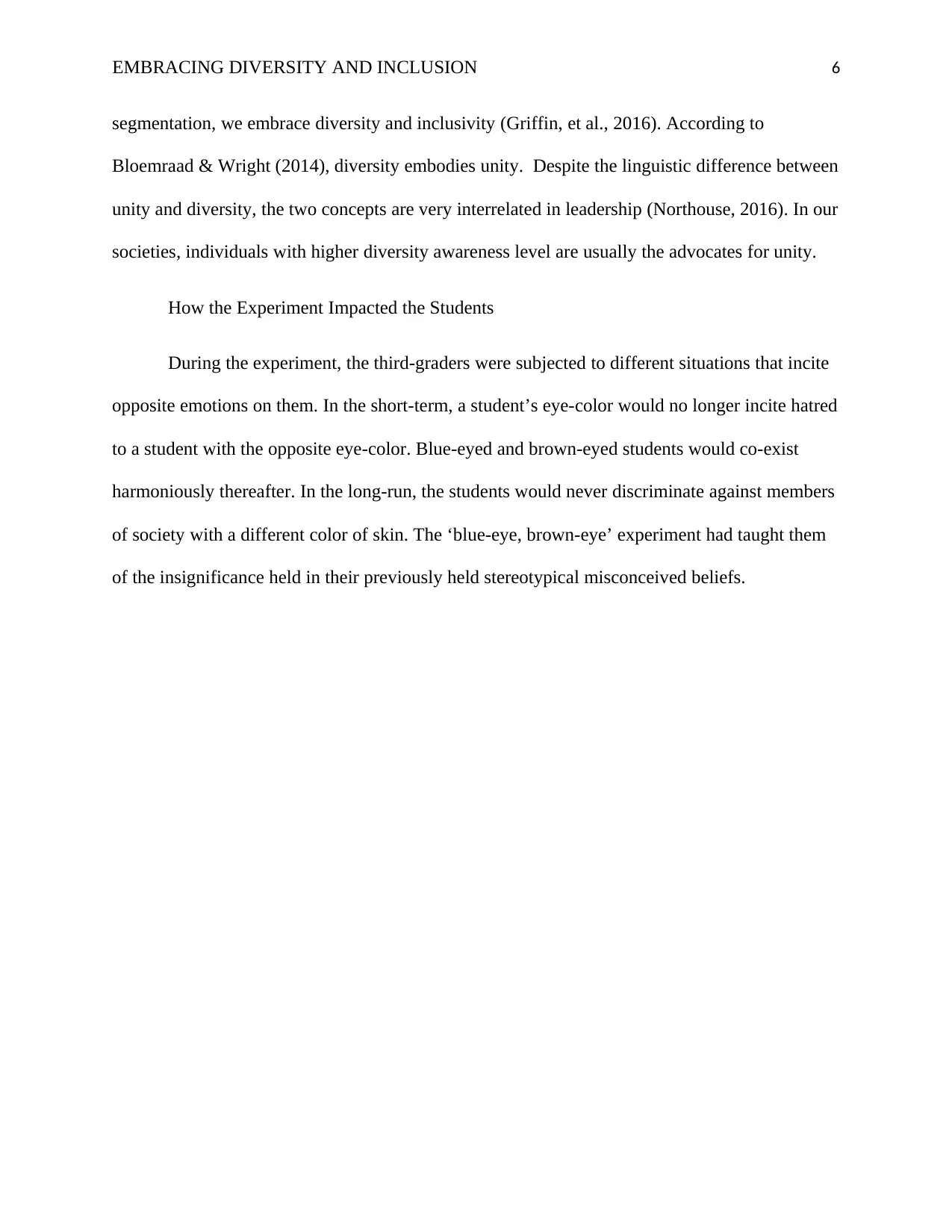
EMBRACING DIVERSITY AND INCLUSION 6
segmentation, we embrace diversity and inclusivity (Griffin, et al., 2016). According to
Bloemraad & Wright (2014), diversity embodies unity. Despite the linguistic difference between
unity and diversity, the two concepts are very interrelated in leadership (Northouse, 2016). In our
societies, individuals with higher diversity awareness level are usually the advocates for unity.
How the Experiment Impacted the Students
During the experiment, the third-graders were subjected to different situations that incite
opposite emotions on them. In the short-term, a student’s eye-color would no longer incite hatred
to a student with the opposite eye-color. Blue-eyed and brown-eyed students would co-exist
harmoniously thereafter. In the long-run, the students would never discriminate against members
of society with a different color of skin. The ‘blue-eye, brown-eye’ experiment had taught them
of the insignificance held in their previously held stereotypical misconceived beliefs.
segmentation, we embrace diversity and inclusivity (Griffin, et al., 2016). According to
Bloemraad & Wright (2014), diversity embodies unity. Despite the linguistic difference between
unity and diversity, the two concepts are very interrelated in leadership (Northouse, 2016). In our
societies, individuals with higher diversity awareness level are usually the advocates for unity.
How the Experiment Impacted the Students
During the experiment, the third-graders were subjected to different situations that incite
opposite emotions on them. In the short-term, a student’s eye-color would no longer incite hatred
to a student with the opposite eye-color. Blue-eyed and brown-eyed students would co-exist
harmoniously thereafter. In the long-run, the students would never discriminate against members
of society with a different color of skin. The ‘blue-eye, brown-eye’ experiment had taught them
of the insignificance held in their previously held stereotypical misconceived beliefs.
⊘ This is a preview!⊘
Do you want full access?
Subscribe today to unlock all pages.

Trusted by 1+ million students worldwide
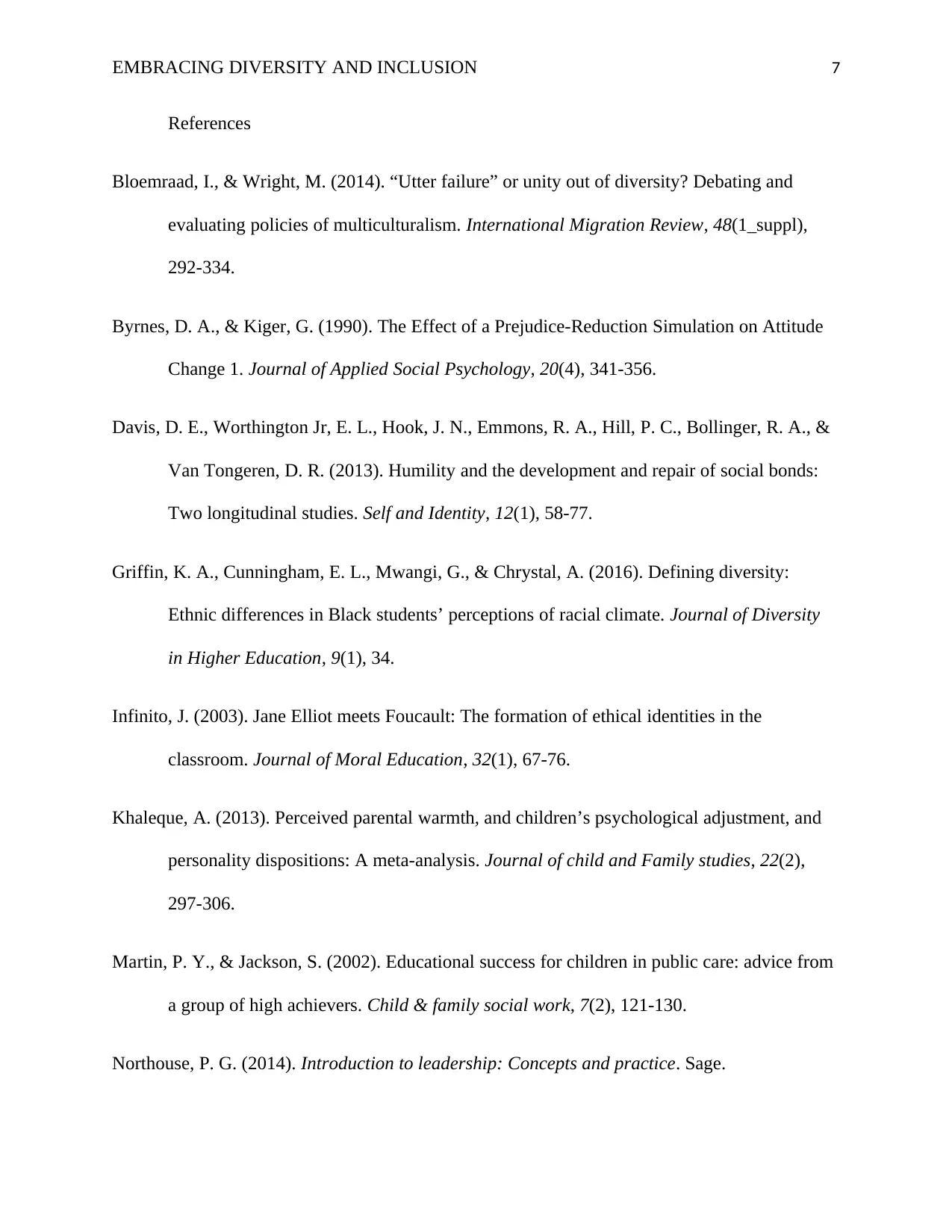
EMBRACING DIVERSITY AND INCLUSION 7
References
Bloemraad, I., & Wright, M. (2014). “Utter failure” or unity out of diversity? Debating and
evaluating policies of multiculturalism. International Migration Review, 48(1_suppl),
292-334.
Byrnes, D. A., & Kiger, G. (1990). The Effect of a Prejudice‐Reduction Simulation on Attitude
Change 1. Journal of Applied Social Psychology, 20(4), 341-356.
Davis, D. E., Worthington Jr, E. L., Hook, J. N., Emmons, R. A., Hill, P. C., Bollinger, R. A., &
Van Tongeren, D. R. (2013). Humility and the development and repair of social bonds:
Two longitudinal studies. Self and Identity, 12(1), 58-77.
Griffin, K. A., Cunningham, E. L., Mwangi, G., & Chrystal, A. (2016). Defining diversity:
Ethnic differences in Black students’ perceptions of racial climate. Journal of Diversity
in Higher Education, 9(1), 34.
Infinito, J. (2003). Jane Elliot meets Foucault: The formation of ethical identities in the
classroom. Journal of Moral Education, 32(1), 67-76.
Khaleque, A. (2013). Perceived parental warmth, and children’s psychological adjustment, and
personality dispositions: A meta-analysis. Journal of child and Family studies, 22(2),
297-306.
Martin, P. Y., & Jackson, S. (2002). Educational success for children in public care: advice from
a group of high achievers. Child & family social work, 7(2), 121-130.
Northouse, P. G. (2014). Introduction to leadership: Concepts and practice. Sage.
References
Bloemraad, I., & Wright, M. (2014). “Utter failure” or unity out of diversity? Debating and
evaluating policies of multiculturalism. International Migration Review, 48(1_suppl),
292-334.
Byrnes, D. A., & Kiger, G. (1990). The Effect of a Prejudice‐Reduction Simulation on Attitude
Change 1. Journal of Applied Social Psychology, 20(4), 341-356.
Davis, D. E., Worthington Jr, E. L., Hook, J. N., Emmons, R. A., Hill, P. C., Bollinger, R. A., &
Van Tongeren, D. R. (2013). Humility and the development and repair of social bonds:
Two longitudinal studies. Self and Identity, 12(1), 58-77.
Griffin, K. A., Cunningham, E. L., Mwangi, G., & Chrystal, A. (2016). Defining diversity:
Ethnic differences in Black students’ perceptions of racial climate. Journal of Diversity
in Higher Education, 9(1), 34.
Infinito, J. (2003). Jane Elliot meets Foucault: The formation of ethical identities in the
classroom. Journal of Moral Education, 32(1), 67-76.
Khaleque, A. (2013). Perceived parental warmth, and children’s psychological adjustment, and
personality dispositions: A meta-analysis. Journal of child and Family studies, 22(2),
297-306.
Martin, P. Y., & Jackson, S. (2002). Educational success for children in public care: advice from
a group of high achievers. Child & family social work, 7(2), 121-130.
Northouse, P. G. (2014). Introduction to leadership: Concepts and practice. Sage.
Paraphrase This Document
Need a fresh take? Get an instant paraphrase of this document with our AI Paraphraser
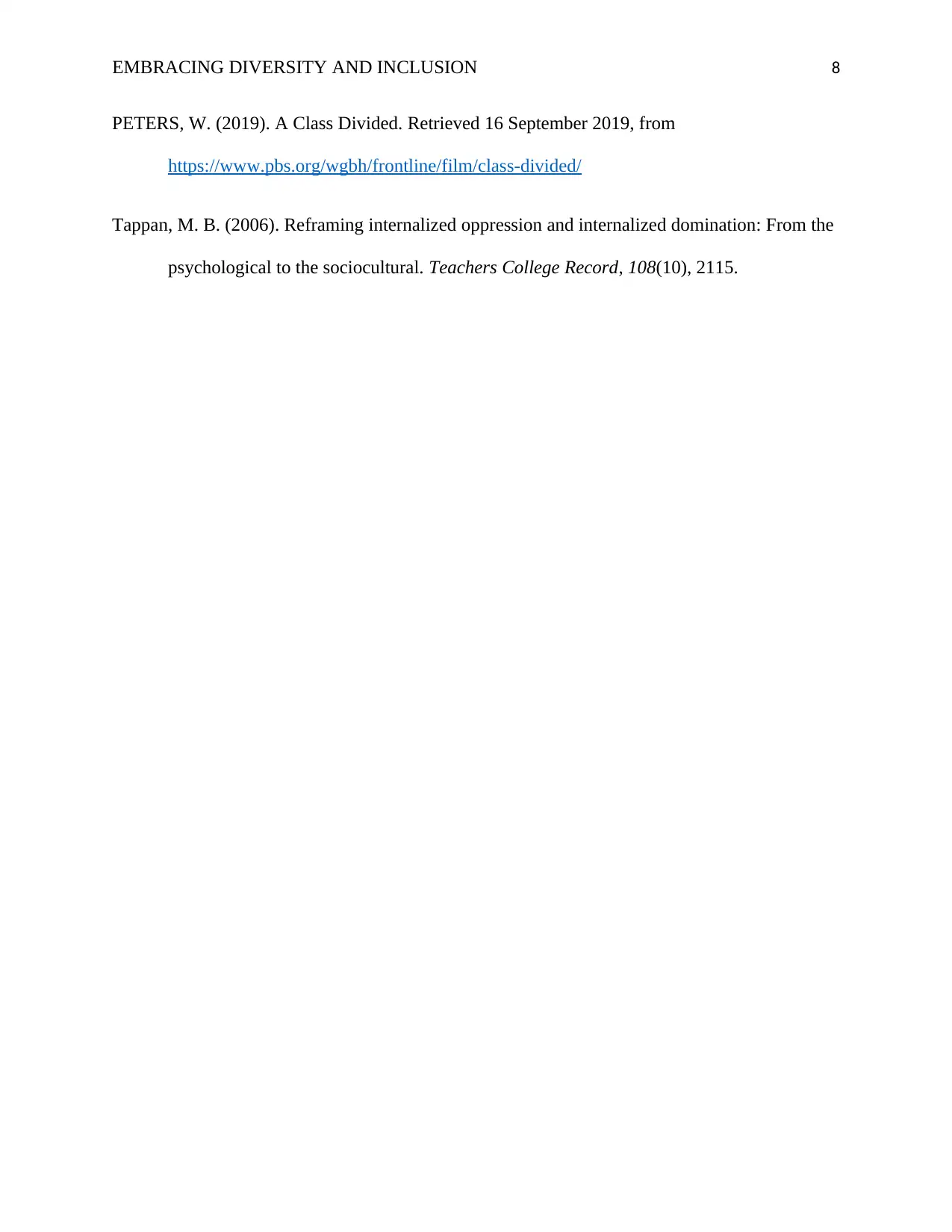
EMBRACING DIVERSITY AND INCLUSION 8
PETERS, W. (2019). A Class Divided. Retrieved 16 September 2019, from
https://www.pbs.org/wgbh/frontline/film/class-divided/
Tappan, M. B. (2006). Reframing internalized oppression and internalized domination: From the
psychological to the sociocultural. Teachers College Record, 108(10), 2115.
PETERS, W. (2019). A Class Divided. Retrieved 16 September 2019, from
https://www.pbs.org/wgbh/frontline/film/class-divided/
Tappan, M. B. (2006). Reframing internalized oppression and internalized domination: From the
psychological to the sociocultural. Teachers College Record, 108(10), 2115.
1 out of 8
Related Documents
Your All-in-One AI-Powered Toolkit for Academic Success.
+13062052269
info@desklib.com
Available 24*7 on WhatsApp / Email
![[object Object]](/_next/static/media/star-bottom.7253800d.svg)
Unlock your academic potential
Copyright © 2020–2025 A2Z Services. All Rights Reserved. Developed and managed by ZUCOL.





